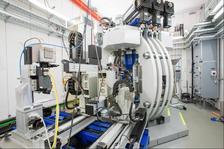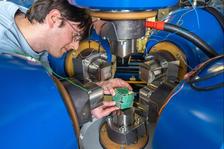The Large Volume Press (LVP) with six rams and the detector positioning system at the PETRA III endstation P61B (Credit: M. Mayer, DESY).
PETRA III is currently the only synchrotron facility that operates a Large Volume Press (LVP) with six hydraulic rams at a beamline. Measurements under extreme pressure and temperature conditions can be performed here to study materials in situ under conditions similar to the interior of the Earth. In the last couple of years since user operation started, the capabilities expanded significantlly at the endstation P61B of the high-energy wiggler beamline, as described in a recent paper published in the Journal of Synchrotron Radiation.
The P61B station at PETRA III features the LVP 'Aster-15', which is a 45-ton heavy and 3.5 m tall machine operating 6 hydraulic rams (6-ram) independently and is capable of generating a maximum load of 15 MN. Only two other such LVPs have been installed in the world at neutron facilities in Germany and Japan. The press is capable of generating ultra-high pressures, over 50 GPa and temperatures, over 3000 K simultaneously as demonstrated by Xie et al., Rev. Sci. Instrum. (2021). Research in the LVP is combined with the brightest white-beam currently available worldwide, offering high-energy X-rays (30 to over 200 keV) produced by an array of 10 damping wigglers at P61. These X-ray beams are specifically suited to energy-dispersive X-ray diffraction combined with collimation to achieve high spatial resolution and low collection times (10 s), probing the diffracted X-rays in a small volume of a mm-sized sample between the X-ray absorbing tungsten carbide anvils. The double-objective X-ray microscope acquires high-resolution radiography images of the sample at a fraction of a second. Additionally, the LVP can be used as a triaxial testing machine capable of controlled rock deformation for in situ studies exploring the rheology of planetary or other materials over a large range of stress and strain rate. New measurement techniques are now available at the beamline P61B: ultrasonic interferometry and acoustic emissions detection. These techniques, when combined with X-rays, can be used to determine the seismic wave propagation and location of brittle deformation in a sample in the LVP, respectively. “Both methods are a key to solving the big questions in seismology and geodynamics on the origin and mechanisms of volcanism and earthquakes in the Earth’s interior”, according to Robert Farla, beamline scientist in charge at P61B. Since user operation started with beam, P61B has produced several publications in high-ranking journals, particularly in close collaboration with the Bayerisches Geoinstitut (BGI) in Bayreuth (Germany), showcasing the latest study by Chanyshev et al., Nature (2022). Also, in Materials science research, several publications were recently produced at P61B on novel nitrides, like e.g. Bhat et al., Chem. – Eur. J. (2020). High pressure synthesis using the large volume press has the potential of discovering novel materials during each experiment, which in turn can be used in a variety of different applications based on the intrinsic properties of the novel compound. For instance novel high-pressure hydrides are investigated, with the prospect to discover potentially high-temperature super-conductors as well as candidates for hydrogen storage. The available techniques are complimented by user-friendly experimental controls, tools for data processing, as well as a conditional service for mail-in experiments. A new in situ LVP beamline is also planned for PETRA IV, ensuring continuity of the success of high-pressure research on large mm-sized samples in the LVP using synchrotron X-rays. In situ high-pressure and temperature studies at PETRA have a bright future ahead. Reference R. Farla, S. Bhat, S. Sonntag, A. Chanyshev, S. Ma, T. Ishii, Z. Liu, A. Néri, N. Nishiyama, G. A. Faria, T. Wroblewski, H. Schulte-Schrepping, W. Drube, O. Seeck and T. Katsura, “Extreme conditions research using the large-volume press at the P61B endstation, PETRA III,” J. Synchrotron Radiat. (2022), DOI: 10.1107/S1600577522001047 Funding information: The research and instrumentation at P61B are supported by the Federal Ministry of Education and Research, Germany (BMBF, Grants No.: 05K16WC2, 05K13WC2, & 05K20OLA) and Vetenskapsrådet (grant No. 2019-06063).







